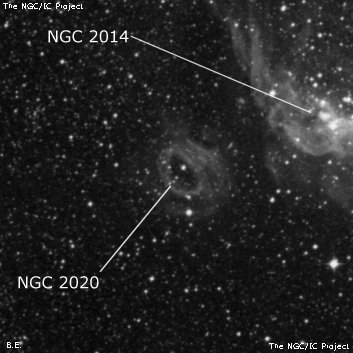
John Herschel discovered NGC 2020 = h2903 on 30 Dec 1836 and recorded "pB; vL; vglbM; lE; 4'. A fine cluster [NGC 2014] precedes it." On the very next sweep he wrote "vF; vL; R; vglbM; 4' diameter." His position is accurate.
James Dunlop possibly discovered NGC 2020 = D 218? earlier in 1826 and described "a pretty bright round nebula, 30" diameter, with a minute star slightly involved in the margin." Dunlop claims two observations and his position is 5' too far NE, well within his usual errors. But this nebula is probably too faint to have been picked up by Dunlop with his 9" reflector and his description could apply to[NGC 2014, which is 9' west of his position. Wolfgang Steinicke attributes Herschel with the discovery and I agree.
600/800mm - 30" (11/5/10 - Coonabarabran, 264x): fairly bright, roundish, annular W-R bubble, slightly elongated SW-NE, 3'x2.5'. The inner edge of the annulus is slightly brighter and sharply defined with a relatively large dark center, ~45" x 30". North of center in the ring is the 13th magnitude Wolf-Rayet star HD 269748 = Brey 48, which appears roughly centered in the emission nebula. A 12th magnitude star lies 1.3' S of the central star, at the southern edge of the nebula. Two fainter stars are just north and south of the mag 12 star and this trio is collinear with the central star. NGC 2020 forms a striking due with NGC 2014 (cluster and emission nebula) 5' WNW. The remarkable Seagull Nebula (NGC 2030, 2032, 2035) lies 15' NE.
Notes by Steve Gottlieb